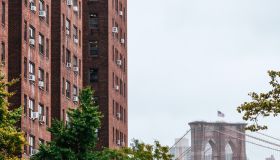The 8 Most Infamous U.S. Public Housing Projects
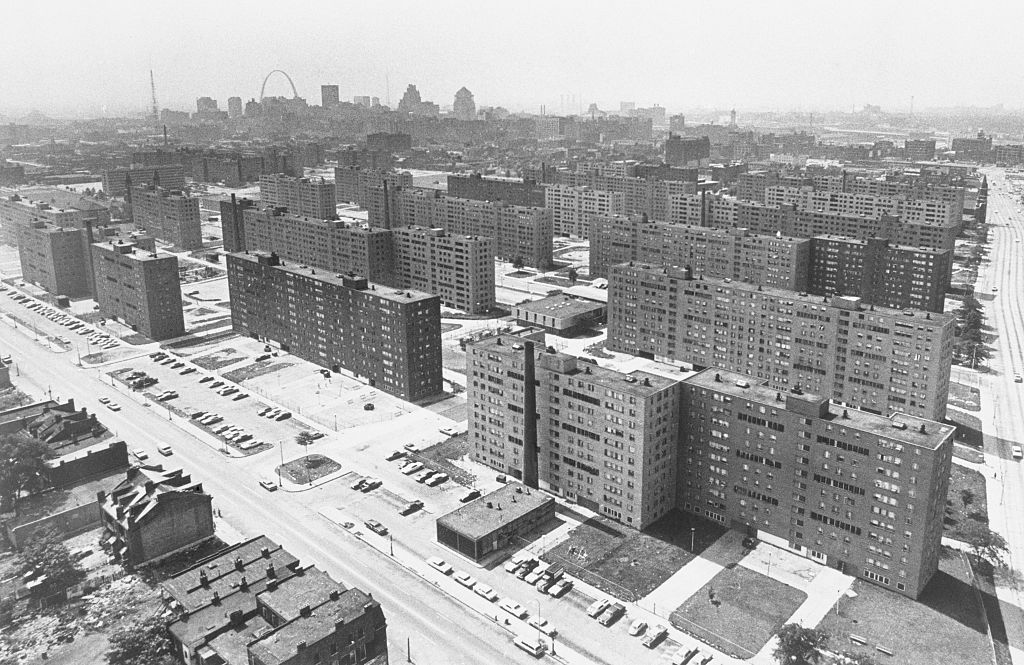
Source: Bettmann / Getty
For decades American government’s efforts to house the poor have relied on the construction of subsidized housing plots more commonly known as “Projects.” The term, originally used to describe the improvement projects city planners believed these developments would amount to, has instead become synonymous with inner-city blight and crime.
The history.
Public housing in the United States has its origins in the late 19th and early 20th centuries, during a time when urban housing conditions were often appalling. As cities rapidly industrialized, waves of immigrants from Europe and Asia sought employment and better living conditions. However, many of them faced overcrowded, unsanitary, and unsafe housing. In response to these dire conditions, social reformers began advocating for government intervention to improve housing for the poor.
In 1937, under President Franklin D. Roosevelt’s New Deal, the Housing Act was passed, marking the beginning of the federal public housing program. The intent behind the program was twofold: to provide affordable housing to low-income families while stimulating the economy through job creation. However, the implementation of the program came at a significant cost to some Black families in America.
As the National Low-Income Housing Initiative (NLIHI) notes, before the Housing Act was officially enacted, one of the first public housing projects under the New Deal was Techwood Homes in Atlanta, Georgia, built in 1935. Tragically, hundreds of Black families were displaced from the area to make way for a 604-unit, whites-only neighborhood. This event marked just the beginning of the challenges that public housing projects would face in the years to come, as racial segregation and exclusion became deeply embedded in housing policies. Today, urban legend, news reports and rap lyrics detail the deadening effects of concentrated poverty and misguided public policy that these “projects” have become.
Let’s take a look at eight of the most notorious housing projects around the United States.
8) Holmes Towers, New York City, NY
Holmes Towers, located on the Upper West Side of Manhattan, has gained notoriety for its poor maintenance and dangerous living conditions. Managed by the New York City Housing Authority (NYCHA), the complex received a dismal rating of just 25 out of 100 following a federal inspection, according to data from the U.S. Department of Housing and Urban Development (HUD), reported by the New York Post in 2018. This score was far below the 60 points required to pass, marking the lowest rating given to any NYCHA-managed property since 2015. Additionally, the Towers ranked among the worst 13 out of more than 3,800 properties nationwide inspected by HUD that year.
Built in 1969, Holmes Towers consists of two 25-story buildings with 634 apartments. In 2018, a resident, Angeles Torre, revealed to the New York Post that the building was in desperate need of bathroom repairs. Torre, 82, expressed frustration over the persistent leak in her bathroom, saying, “There’s a leak in the bathroom above mine, and that’s what’s doing this. I go to the management office and they just say, ‘You’re in the system. Just wait for the painters.’ ”
Another resident, Meleney Leneras, recounted how she and her daughter suffered from asthma due to mold in their bathroom. When she called NYCHA to report the issue, the response was disheartening, they allegedly told her to “‘Just spray it with bleach.’”
It’s unclear if improvements have been made since then. In 2019, The City reported that NYCHA estimated Holmes Towers would need immediate repairs worth around $36 million, with over $100 million required for further work over the next two decades.
7) Pruitt-Igoe, St. Louis, MO
Designed by architect Minoru Yamasaki, who later designed the World Trade Center towers, Pruitt-Igoe was first occupied in 1954 but completed in 1956. Because Missouri public housing was racially segregated until 1956, the 33 11-story buildings were originally built to house segregated sects of young, middle-class whites and Blacks; but the projects became the home of mostly African American inhabitants as St. Louis’ white population fled for the suburbs.
Unlike most public housing plots, Pruitt-Igoe survived for only a short period of time. Critics say design failures, including “Skip-stop” elevators which only stopped at every three floors contributed to the downfall of the once heralded housing development. Reports of muggers waiting to rob residents in the stairwells as they trekked between elevator floors fueled high crime rates.
By 1971, Pruitt–Igoe housed only six hundred people in 17 of its original 33 buildings. That same year, federal authorities agreed to demolish parts of Pruitt-Igoe. By 1976, the rest of the Pruitt–Igoe was demolished.
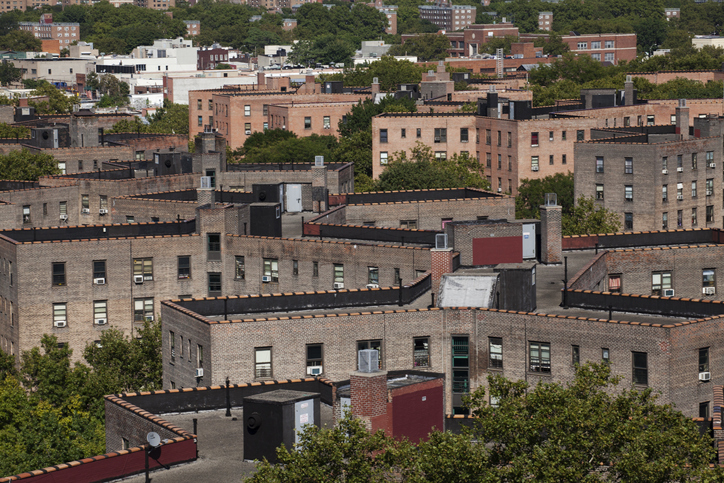
Source: Erik Von Weber / Getty
6) Queensbridge Houses, Queens, NY
The 3,142-unit Queensbridge Houses is the largest public housing development in the U.S. Located in the western part of the borough of Queens, the houses are technically two separate complexes (North and South Houses) that house nearly 7,000 people. Architects designed the collection of six-story buildings in a unique Y shape hoping to give residents more access to sunlight.
During the 1950s, a majority of Queensbridge residents were white. Since, they have become inhabited by predominantly African American and Latino families. Like many of the infamous housing projects, Queensbridge was the home to a host of notable hip-hop artists (Nas, Marley Marl, MC Shan, Roxanne Shante and Mobb Deep) who have detailed the housing project’s poverty-stricken conditions in their rhymes. Gun violence and a vibrant illegal drug-trade sum up their details of the harsh realities living in Queensbridge.
In 2005, Queensbridge made news after New York authorities raided the housing project to dismantle the infamous “Dream Team” drug syndicate.
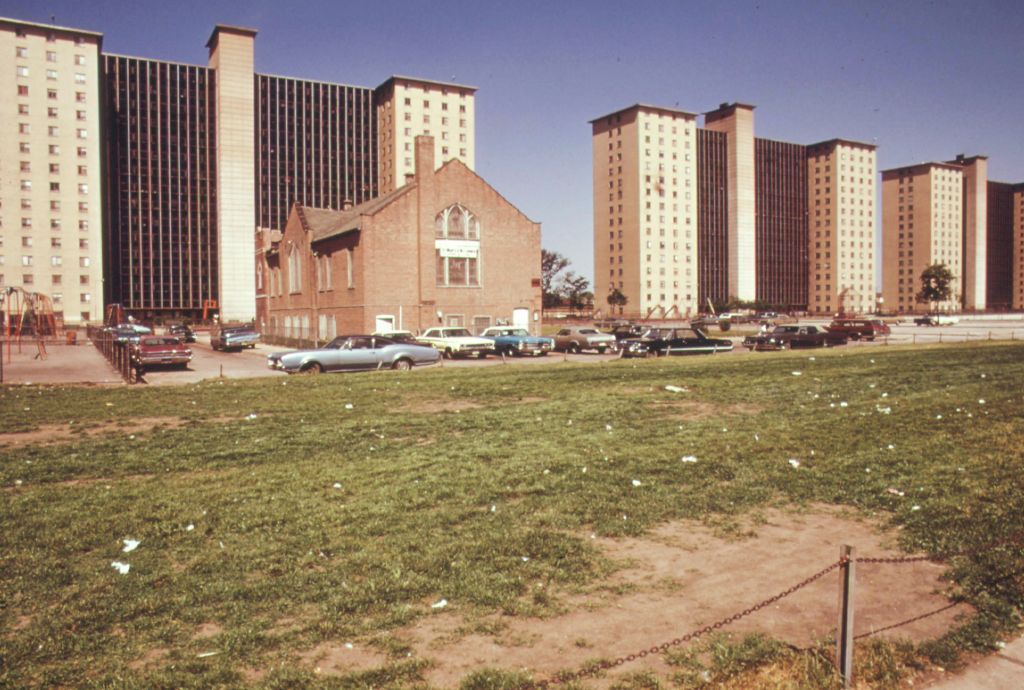
Source: Smith Collection/Gado / Getty
5) Robert Taylor Homes, Chicago, IL
Located in the Bronzeville neighborhood of the South Side of Chicago, the Robert Taylor Homes were at one time the largest public housing development in the country. Completed in 1962, the developments were named after Robert Taylor, the first Black student to enroll at the Massachusetts Institute of Technology back in 1888.
Composed of 24 16-story high-rises and a total of 4,415 units, the Robert Taylor Homes were once home to Mr. T, athletes Kirby Puckett and Maurice Cheeks, and the current governor of the state of Massachusetts Deval Patrick.
During its time, the Robert Taylor homes housed some of the poorest residents in the country. A 1999 article reported that 95 percent of the housing development’s 20,000 residents were unemployed and listed public assistance as their only income source. With such poverty, the Robert Taylor Homes recorded some of the highest rates of violent crime and gang activity in Chicago.

Source: Chicago History Museum / Getty
4) Jordan Downs, Watts, CA
Originally constructed in the Watts section of Los Angeles as temporary housing for war workers during World War II, but converted to public housing in the early 1950s, the Jordan Downs Housing projects is one of the few public housing developments named after regular people (David Starr Jordan, and Samuel Elliot Downs, two of the area’s oldest residents).
What started as a partially integrated development in its early years, became majority African American by the mid-60s due to Los Angeles’ restrictive covenants and an influx of African Americans who continued to migrate west after the war. Since, Jordan Downs has become a microcosm of the ills of South Los Angeles. Police brutality and a lack of employment fueled a sense of hostility among African Americans living in Jordan Downs and throughout Watts. The world witnessed these social tensions during the 1965 Watts riots. Gang violence in the 80s and 90s highlighted the plight that still persists today, History noted. Rising tensions between residents and law enforcement exploded into riots that lasted six days, stretching across 50 square miles. The unrest resulted in 34 deaths, over 1,000 injuries, and the destruction of 600 buildings, according to NBC News.
Since then, Jordan Downs and the rest of Watts have remained notorious for high crime rates and poverty. Employment rates are dismal, with only one-third of residents between the ages of 18 and 60 holding jobs, and average household incomes are below $16,000 annually. The project’s robbery rate is five times higher than the city’s average, based on population, the outlet reported.
In 2020, the Housing Authority of the City of Los Angeles (HACLA) announced a $1 billion redevelopment plan for Jordan Downs. As part of this initiative, the project which is being constructed with $37.3 million loan, according to Urbanize, includes the construction of a 92-unit apartment complex for residents earning between 30% and 80% of the area’s median income.
HACLA, in partnership with Bridge Housing and The Michaels Organization, wants to take a comprehensive approach to revitalizing Jordan Downs. The project includes the development of new housing, retail spaces, job opportunities, childcare, parks, and other community amenities, all while ensuring that current residents are not displaced. When completed, the redevelopment will bring 1,569 new affordable and market-rate housing units to the area, HACLA claimed.

Source: Michael Blackshire / Getty
3) Magnolia Projects, New Orleans, LA
Officially named the C.J. Peete Projects, the Magnolia Projects were built in a part of Uptown New Orleans known as Central City.
When construction began in 1941, the development bordered Louisiana Ave., Magnolia Street, Washington Ave. and La Salle Street. Fourteen years later, the complex was expanded north six additional city blocks to Clara Street. Flint Goodridge Hospital, African American New Orleanians’ primary source for medical care from the time of Jim Crow until the 1980s when it closed, was located in Magnolia’s southwest corner.
Rife with all the urban blight consistent with many poor areas and public housing developments, Magnolia’s murder rate consistently ranks the highest of all the city’s public housing developments, a startling fact considering that New Orleans itself frequently has one of the highest murder rates in the nation.
The Dooney Boys, one of New Orleans’ largest street gangs, calls Magnolia its home. More notably, Magnolia has bred many of the south’s biggest hip-hop artists including Juvenile, Soulja Slim, and Jay Electronica.
2) Marcy Projects, Brooklyn, NY
Located in the Bedford-Stuyvesant neighborhood of Brooklyn, the Marcy Houses or Marcy Projects were named after William L. Marcy, the 11th Governor of New York, who later served as the U.S. Secretary of War and U.S. Secretary of State. Its 1,705 apartments house more than 4,200 residents.
Known as the childhood home of rapper Jay-Z, Marcy ‘s infamous reputation has been documented in countless rap songs. Jay-Z ‘s “Murder Marcyville” was named to describe the development’s violent lure. And his “Where I’m From” track details the poverty and prevalence of gun violence and crack cocaine that consumed the housing development. In the song, Jay-Z raps “ [I’m from…] Where you can’t put your vest away and say you’ll wear it tomorrow / Cause the day after we’ll be saying, damn I was just with him yesterday.”
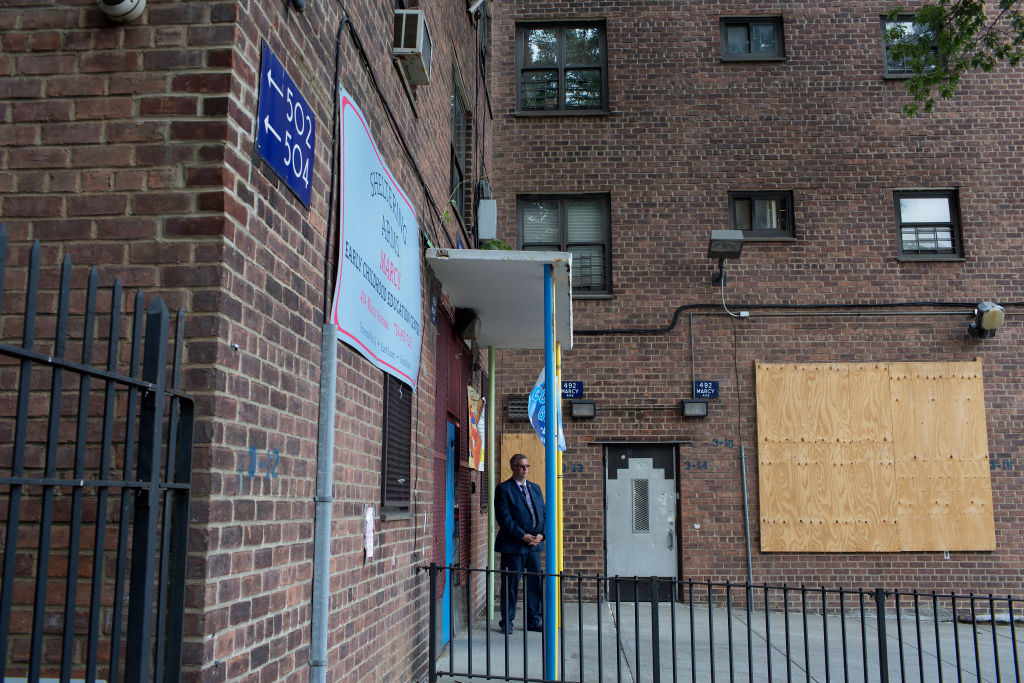
1) Cabrini Green, Chicago, IL
Originally named the Frances Cabrini Rowhouses after Frances S. Cabrini, the first American citizen to be canonized by the Roman Catholic Church, the public housing development on Chicago’s near North Side was bordered by Evergreen Ave. on the north, Orleans Street on the east, Chicago Ave. on the south, and Halsted Street on the west. Made up of 3,607 units at its peak, Cabrini Green housed more than 15,000 people.
After nearby factories closed in the 1950s leaving many of Cabrini Green’s working-class residents out of work, poverty and crime began infecting the development. Since, Cabrini Green’s poverty-stricken high crime conditions have been documented more than any of Chicago’s housing projects. USA Today described Cabrini Green as “a virtual war zone, the kind of place where little boys were gunned down on their way to school and little girls were sexually assaulted and left for dead in stairwells.”
In 2010, Chicago closed Cabrini Green.
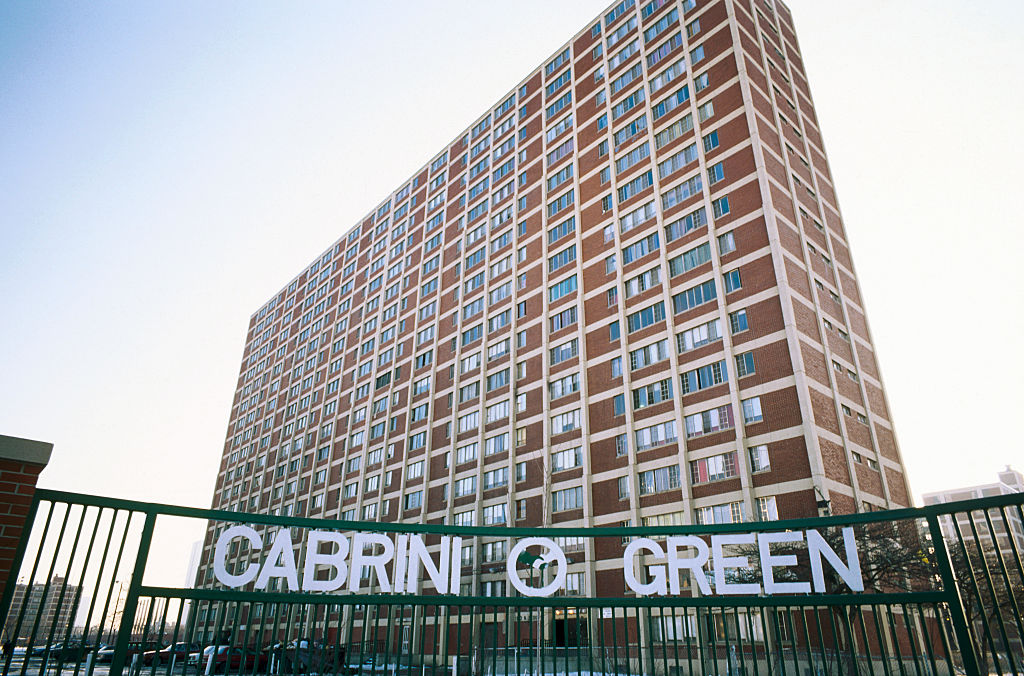
SEE ALSO:
